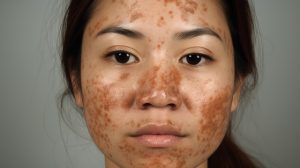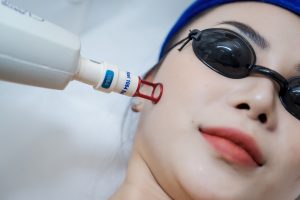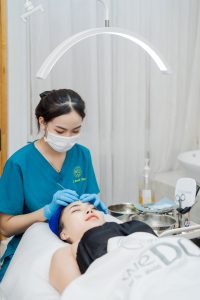Melasma Treatment: Discover the Best Options for Your Skin
Melasma is a common skin condition affecting millions worldwide. Characterized by dark, brown patches on the face, often appearing on the cheeks, forehead, nose, and upper lip, melasma is caused by an overproduction of melanin. While not a serious health concern, melasma can be frustrating and impact self-esteem. Discover effective treatment options and learn how to manage melasma for a more radiant complexion.
CONTENT
Causes of Melasma
The exact causes of melasma are not fully understood, but several factors are believed to contribute to its development:
- Hormonal changes: Hormonal fluctuations, such as those that occur during pregnancy, menopause, or while taking birth control pills, can trigger melasma.
- Sun exposure: Ultraviolet (UV) radiation from the sun can stimulate melanin production, leading to darker patches.
- Genetics: Some people may have a genetic predisposition to developing melasma.
- Medications: Certain medications, including anticonvulsants and antipsychotics, can increase the risk of melasma.

Symptoms & Diagnosis of Melasma
The primary symptom of melasma is the appearance of dark, brown patches on the skin. These patches may be flat or raised, and they can vary in size and shape. In some cases, the patches may be itchy or sensitive to the sun. While it’s not usually a serious health concern, accurate diagnosis is crucial for selecting the most effective treatment. These are some common diagnostic methods that dermatologists use to define melasma condition:
- Visual examination: A dermatologist will often begin by visually examining the affected areas of your skin. They will look for the characteristic brown or gray patches, their location, and any associated symptoms like itching or sensitivity.
- Medical history: Your dermatologist will ask about your medical history to identify any potential contributing factors. This may include questions about: Hormonal changes (pregnancy, menopause, birth control, sun exposure habits, family history of skin conditions, or medications you’re currently taking.
- Wood’s Lamp Examination: In some cases, a Wood’s lamp, a special light that emits ultraviolet A (UVA) rays, may be used. Melasma often appears darker under a Wood’s lamp, helping to distinguish it from other skin conditions.
- Skin Biopsy: Although less common for melasma, a skin biopsy may be necessary if the dermatologist suspects another skin condition, such as a mole or melanoma. This involves removing a small sample of skin for examination under a microscope.

It’s important for your dermatologist to rule out other conditions that may mimic melasma, such as:
- Hyperpigmentation: This can occur due to various factors, including sun damage, inflammation, or certain medications.
- Post-inflammatory hyperpigmentation: This is a common condition that occurs after skin inflammation, such as acne or injury.
- Addison’s disease: A rare endocrine disorder can cause hyperpigmentation, including melasma-like patches.
- Malignant melanoma: While less likely, it’s essential to rule out melanoma, especially if you have a new or changing mole.
Accurate diagnosis is crucial for effective treatment. By understanding the diagnostic process and working closely with a qualified dermatologist, you can receive the appropriate care for your melasma and achieve the desired results.
Treatment Options for Melasma
There are several treatment options can help to improve the appearance of the dark patches. The best treatment for you will depend on the severity of your melasma and your individual preferences.
- Topical treatments: Topical creams and ointments containing hydroquinone, kojic acid, or azelaic acid can help to lighten the dark patches.
- Chemical peels: Chemical peels can help to exfoliate the top layer of skin and reduce the appearance of melasma.
- Laser therapy: Laser therapy can target the melanin in the skin and help to lighten the dark patches.
- Intense Pulsed Light (IPL): IPL can help address melasma and other pigmentation concerns.
- Sun protection: Protecting your skin from sun exposure is essential for preventing melasma and managing existing conditions. Use a broad-spectrum sunscreen with an SPF of 30 or higher every day.

At WEDO, we believe in a holistic approach to melasma treatment. Our dermatologists will carefully assess your skin condition, lifestyle, and preferences to develop a personalized treatment plan for each customer.
Why Choose WEDO for Melasma Treatment?
- Experienced Dermatologists: Our team of board-certified dermatologists has extensive experience in treating melasma and other skin conditions.
- Advanced Technology: We utilize the latest low-fluence 1064 nm Q-switched Nd:YAG laser and IPL technologies for effective and minimally invasive treatments.
- High-end cosmeceutical products: We provide topical products from the world’s leading cosmeceutical brands in the treatment of melasma, with many different segments for you to choose from.
- Personalized Care: Your comfort and satisfaction are our top priorities. We’ll work closely with you to achieve your desired results.
- Comprehensive Approach: We offer a range of treatment options to address the unique needs of each patient.

Schedule a Consultation Today
Ready to take the first step toward clearer, more confident skin? Contact WEDO to schedule a consultation with one of our experienced dermatologists. We’ll discuss your concerns, assess your skin, and recommend the best treatment plan for you.
Say goodbye to dark spots and hello to confidence!
Sunlight is one of the main factors that negatively affect a woman’s beauty, and using sunscreen products is an essential step in any beauty routine. If you pay attention, you’ll notice the SPF and PA indicators on product packaging. But do you know what they mean?
Children’s skin is very thin, only about one-fifth as thick as an adult’s skin. Their delicate and sensitive skin, combined with a weaker immune system, makes children more susceptible to damage from external factors that can lead to dermatological conditions. Let’s take a look at some common skin diseases in children:


